The Bremer Counter Attack
First of all using the Anglo-Scandinavian as a weapon against 1.c4 and using it to bust the English. The author, Timo Immonen, who uses Alexander Jalo as his nom de plume, has actually written the quoted trilogy, the second volume of which contains the chess section. As mention in the end of his article Timo's work on this opening started in 1993 and the results come from 200,000 machine hours of research. That produced a 65 MB database with 40,000 games, with the main main lines highlighte and false moves marked "don’t play in tournament".
Timo in fact sent us a sample of 300 computer games to illustrate the validity of his conclusions. Since they were played between opponents rated well over 3000 Elo one needs to take this seriously. We have passed the games on to experts, who are conducting additional tests with the author.
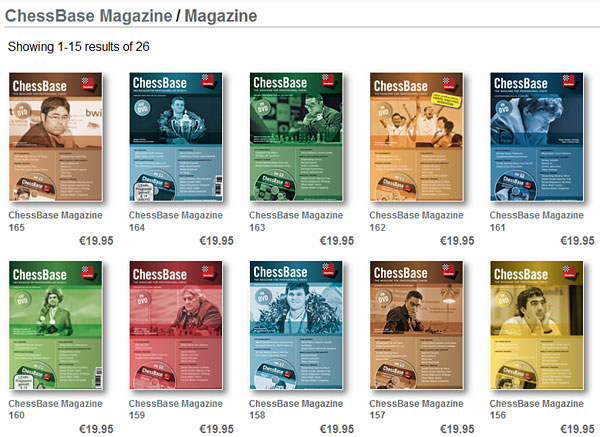
At some stage in the near futur expect to see a full article with final conclusions from Timo Immonen's
research in ChessBase Magazine. There are plenty of English fans looking forward to that.
Google Tooth

This was of course the prank – unless you are willing to believe that people are going to have molars extracted to accomodate Android implants. It's not going to happen – for a few years at least. A number of readers spotted the point of the joke: such a device would spell the end of chess. Anyone with a Tooth installed would be turned into a 3000+ rated player, and detection would be practically impossible (imagine dental examinations at a big open tournament).
One interesting aspect of our bionic fantasy was mentioned by a couple of readers: a Google Tooth would be an ideal device for regular phone calls. No mikes or headphones, taking a call only involves a tap of the tongue – definitely superior to the iWatch. Well, dream on.
Addendum: One remarkable letter we received, after this article went live, was from an anonymous "Ed" in the USA: "Only stupid idiots like you publish April fools articles. It is very unprofessional to mislead your faithful readers. It is my hope that you get into some king of legal problems one day due to your stupid April fool religion." Sorry you didn't catch it, Ed. But the tradition is alive and healthy, with Silicon Valley leading the pack. Google, which began posting jokes on its site in 2000, this year turned Google Maps into a giant Pac-Man game, which is still functioning in a normal Google Maps search! Will they make it permanent? Google also offered a fully functional mirror version (elgoog.im) of its search page to celebrate the first of April. We also enjoyed their Underwater and Gravity searches. Not to mention the MS-DOS version, which shows you what Google would look like if it were developed in the 80s. Hilarious. No, the people in Mountain View have humour – we don't believe they will sue.
A minor planet named Vishyanand
This was the fake April Fool's article that fooled most people. We switched off discussion at the end of the article in order to prevent people from telling everyone that the story was perfectly true, in every aspect – and to avoid embarrassing anyone. We will not quote the letters we received with the names of the authors, just give you an anonymous sample:
-
R.M. London: Always thought Vishy's style was "out of this world". Sadly, I fear that the date of this article is more indicative of how true the article is!
-
V.M., India: I was waiting for the April 1st article. This one i caught just from reading the heading.
-
J.S. Japan: I liked this joke because it is creative and interesting. Time flies! It is already April 1st. I just remembered the article you posted telling that Magnus Carlsen is Matt Damon’s cousin. Thanks for making the day happier
-
D.Y. USA: Sounds plausible, but given that today is April 1, I have a hunch that it is a prank.
-
D.D Bahrain: What an great April Fool Joke! Well done.
And dozens more. But there were some who got it right:
-
Alan O'Brien, London: He is not the first. Vasily Smyslov has an asteroid named after him. 5413 Smyslov.
-
Christian Sasse, Vancouver: Well written and very precise. It should be added that (4538) Vishyanand is also known to have a surface temperature that does not exceed 64 Kelvin. This was somewhat unexpected and it is believed that this is due an the high eccentricity of its orbit almost resembling a rectangular shape.
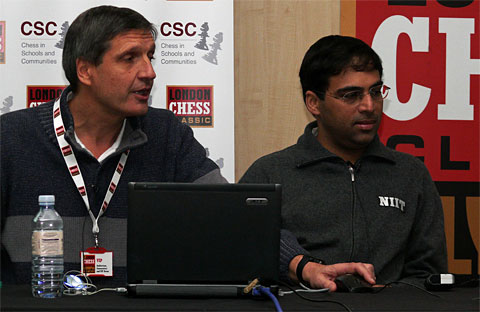
Dr Sasse is of course the astronomer who runs the iTelescope facility that Anand periodically uses.
Anand himself was skeptical about the report: "I'm hedging my reactions – it's a joke, right?" Come on, lazybones, just google it, like many of our readers did.
But the hero behind the (4538) Vishyanand story is Michael Rudenko, who send us a follow-up article explaining how the names of minor planets are given, and how you can honor a chess player yourself.
The naming of coments and minor planets
By Michael Rudenko
The first minor planet (also called 'asteroid', though that term has fallen somewhat out of favor with astronomers) was discovered on 1801 January 1. After much bickering, it came to be named 'Ceres', adhering to the convention that the planets were named for mythological characters (Mercury, Venus, etc.). This discovery was soon followed by discoveries of minor planets Pallas, Juno, and Vesta. As some considerable time could pass between a discovery and a name being agreed upon, to facilitate distinguishing minor planets each object was assigned a numeric designation -- leading to (1) Ceres, (2) Pallas, etc.
As the number of known minor planets went from tens to hundreds to thousands, it no longer became feasible to stick to the mythological term naming convention. Minor planets started being named for places ((8837) London, (204852) Frankfurt), and people such as scientists ((2001) Einstein, (10204) Turing), writers ((2675) Tolkien, (2985) Shakespeare), actors ((9620) Ericidle, (13070) Seanconnery), athletes ((6758) Jesseowens, (128036) Rafaelnadal), artists ((6677) Renoir, (4221) Picasso), musicians ((1815) Beethoven, (6354) Vangelis), and yes, even chess players. I am delighted to announce that minor planet (4538) will henceforth officially be known as (4538) Vishyanand. Included with the orbit and observation details about(4538) Vishyanand, is this citation:
(4538) Vishyanand = 1988 TP
Discovered at Toyota on 1988-10-10 by K. Suzuki. Viswanathan (Vishy) Anand (b. 1969) was India's first chess grandmaster. He went on to become the fifteenth undisputed world chess champion. In addition to his passion for chess, he is also an avid astrophotography enthusiast.
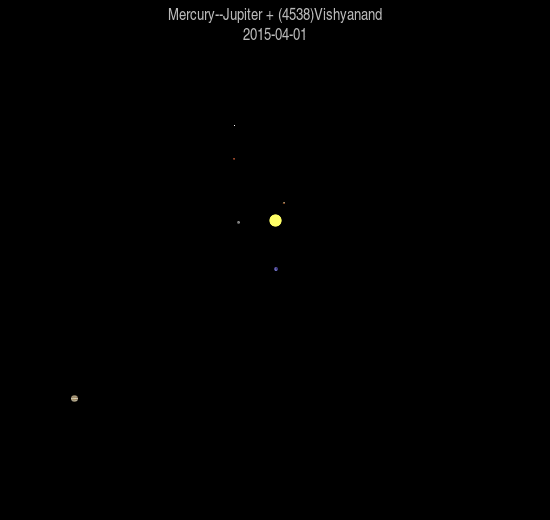
This animation shows the motion of the planets Mercury through Jupiter and (4538) Vishyanand -- the white dot moving in the area between the orbits of reddish Mars and largish Jupiter -- over the course of the next three and three-quarter years, the time it takes it to complete a single orbit around the Sun. An interactive orbit diagram of (4538) Vishyanand is available here .
To date, only a handful of chess players have been likewise honored having minor planets named for them. They are:
-
(1909) Alekhin = 1972 RW2
Discovered at Nauchnyj on 1972-09-04 by L. V. Zhuravleva. Named in honor of Aleksandr Aleksandrovich Alekhin (1892-1946), an outstanding Russian chess-player, the world chess champion (1927-1935, 1937-1946).
-
(5413) Smyslov = 1977 EC2
Discovered at Nauchnyj on 1977-03-13 by N. S. Chernykh. Named in honor of Vasilij Vasilevich Smyslov (b. 1921), Soviet chess grandmaster and world chess champion during 1957-1958. He is known also as a gifted amateur singer, performing operatic arias and Russian folk songs.
-
(5570) Kirsan = 1976 GM7
Discovered at Nauchnyj on 1976-04-04 by N. S. Chernykh. Named in honor of Kirsan Nikolaevich Ilyumzhinov (b. 1962), chess grandmaster and president of the International Chess Federation, elected in 1996 for a second term.
-
(7268) Chigorin = 1972 TF
Discovered at Nauchnyj on 1972-10-03 by L. V. Zhuravleva. Mikhail Ivanovich Chigorin (1850-1908), founder of the Russian chess school, was Russian chess champion from 1899 to 1906. He gained victories in international chess tournaments in New York (1889), Budapest (1896) and Vienna (1903).
- (90414) Karpov = 2003 YP110
Discovered at Pla D'Arguines on 2003-12-19 by R. Ferrando. Anatoly Karpov (b. 1951) learned chess from his father at the age of four and was soon able to beat older players. He was world chess champion from 1975 to 1985 and from 1993 to 1999. He has won more tournaments than any other player in the history of the game.
The only other minor planets citations which contain references to chess are:
-
(17518) Redqueen = 1992 YD
Discovered at Yakiimo on 1992-12-18 by A. Natori and T. Urata. The Red Queen is one of the chess pieces that make up the characters in Lewis Carroll's 'Through the Looking Glass and what Alice found there'. Alice has some very strange experiences and conversations with her.
-
(17612) Whiteknight = 1995 UW6
Discovered at Chichibu on 1995-10-20 by N. Sato and T. Urata. The White Knight is one of the chess pieces that make up the characters in Lewis Carroll's 'Through the Looking Glass and what Alice found there'. He often falls off his horse. He and the Red Knight fight to decide whose prisoner Alice shall be.
-
(26661) Kempelen = 2000 WY67
Discovered at Ondrejov on 2000-11-27 by P. Kusnirak. Wolfgang Kempelen (1734-1804), a polymath, mechanic and inventor, constructed a speech machine in 1778 based on imitating the human vocal organs. His most famous inventions are a chess machine, a writing machine for the blind and a pressurised conduit that took water from the Danube to Bratislava Castle.
-
(35087) von Sydow = 1990 UE5
Discovered at La Silla on 1990-10-16 by E. W. Elst. Max von Sydow (b. 1929), a Swedish screen actor, played in several films under the directorship of Ingmar Bergman. Best known is his performance in 'Det Sjunde Inseglet' ('The Seventh Seal'), where he plays chess with Death.
-
(78071) Vicent = 2002 LT6
Discovered at Pla D'Arguines on 2002-06-01 by R. Ferrando. Born in the city of Segorbe, Francesch Vicent (1450-1512) wrote the first treatise on modern chess, 'Libre dels jochs partits dels schacs en nombre de 100', published in Valencia in 1495. A book of chess openings--and lost since the early nineteenth century--it discussed in particular the moves of the queen and bishops.
-
(126315) Blathy = 2002 AH130
Discovered at Piszkesteto on 2002-01-13 by K. Sarneczky and Z. Heiner. Hungarian electrical engineer Otto Blathy (1860-1939) made significant contributions to the development of the electric transformer, the tension regulator, the wattmeter and the alternating-current electric motor. He was also a chess enthusiast noted for mastering long sequences of moves.
-
(300909) Kenthompson = 2008 BZ45
Discovered at Vail-Jarnac on 2008-01-30 by T. Glinos and D. H. Levy. Kenneth Lane Thompson (b. 1943) is a computer scientist and winner of the Turing, Hamming Medal, National Medal of Technology and Japan Prize awards. He created the B programming language, the UTF-8 character encoding and the Belle chess machine, and was co-creator of the UNIX and Plan 9 operating systems.
Technical information about the orbits and observations of these objects are available by entering a name (or minor planet number) in the 'Data about an object' form at the Minor Planet Center database search page.
A list of currently named minor planets is available here. For those interested in knowing the details about the names, the definitive reference is the two volume 'Dictionary of Minor Planet Names' by Lutz D. Schmadel, now in its sixth edition.
The privilege of suggesting a name for a minor planet usually resides with its discoverer. However, ChessBase.com readers are invited to submit suggestions, via feedback to this article, of chess players who they feel are deserving to join this exclusive club in the sky. A brief proposed citation should be included. The author cannot make any promises that the names will used, but may make a few of the better entries available to the names committee for their consideration.
 |
Michael Rudenko is a staff member of the International Astronomical Union Minor Planet Center in Cambridge, Massachusetts, USA. After receiving an SB in mathematics from MIT in 1977, he has been engaged in computer programming ever since. His name is attached to three comet discoveries he made during the 1980s.
Mike has been afflicted with chess fever since even before the days of Fischer-Spassky '72. When he is not computing orbits of minor planets and comets, Michael enjoys playing blitz on Playchess.com.
As best he can tell, he is not related to the second women's world chess champion, Lyudmila Rudenko. |
Editorial addendum
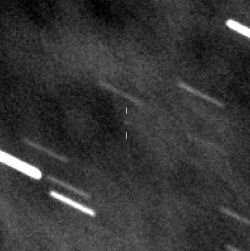 We wanted to rename a specific asteroid, one about which we had written an extensive article entitled "Will the world end on Kasparov's 66th birthday?" The article appeared after a large rock – or small asteroid – was discovered in June 2004 by astronomers at the Kitt Peak National Observatory in Arizona (telescope image on the right). We wanted to rename a specific asteroid, one about which we had written an extensive article entitled "Will the world end on Kasparov's 66th birthday?" The article appeared after a large rock – or small asteroid – was discovered in June 2004 by astronomers at the Kitt Peak National Observatory in Arizona (telescope image on the right).
"2004 MN4", the unimaginative name given to this Earth-crossing object, is estimated to be 400 meters (1300 feet) in length and to have a mass of around one million metric tons. It will cross Earth's orbit in 2029, and in 2004 NASA gave a 1 in 37 or 2.7% possibility of Earth impact – the highest probability for any asteroid ever observed. An impact would have the energy of about 1400 megatons of TNT, 25 times more than the largest thermo-nuclear bomb ever tested and about 100 times more powerful than the Tunguska explosion over Siberia in 1908.
New calculations and radar measurements with the Arecibo radio telescope in Puerto Rico subsequently revealed that there is a zero percent chance of Earth impact. 2004 MN4 will pass the earth at a distance of 36,350 km (or 22,600 miles), which is closer to the planet than geosynchronous satellites that relay TV and communication signals. The flyby will occur on April 13, 2029, which coincidentally is a Friday (paraskavedekatriaphobes take note!) and, even more ominously, Garry Kasparov's 66th birthday! When we told him about NASA's findings at the time Garry expressed relief: "Thank heavens. You know that people would have blamed it on me!"
Our attempt to rename 2004 MN4 after Kasparov failed, since it had already been given the name "(99942) Apophis" – after the Egyptian god of evil and destruction who dwelled in eternal darkness. What a pity, "(99942) Garrykasparov" would have been so very appropriate. |
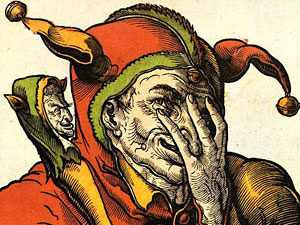






















 We wanted to rename a specific asteroid, one about which we had written an extensive article entitled "
We wanted to rename a specific asteroid, one about which we had written an extensive article entitled "




